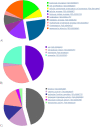Bioinformatics Analysis to Find Novel Biomarkers for Coronary Heart Disease
- PMID: 36407720
- PMCID: PMC9643247
- DOI: 10.18502/ijph.v51i5.9430
Bioinformatics Analysis to Find Novel Biomarkers for Coronary Heart Disease
Abstract
Background: Coronary heart disease (CHD), a major cause of death worldwide, is defined as a narrowing or blockage of the coronary arteries that supply oxygen and blood to the heart. We aimed to find potential biomarkers for coronary artery disease, by comparing the expression profile of blood exosomes of both normal and CHD samples.
Methods: Datasets of 6 CHD and 6 normal samples of blood exosomes were downloaded, and differentially expressed RNAs, with adjusted P<0.01 and log2FoldChange≥1 were achieved. Moreover, gene ontology (GO) and pathway analysis were accomplished by PANTHER database for datasets.
Results: Our data analysis found 119 differentially expressed genes between two datasets. By comparing transcriptome profiles, we candidate the highest downregulated gene, ACSBG1, and the highest upregulated one, DEFA4, as specific biomarkers for CHD. Furthermore, GO and pathway analysis depicted that aforementioned differentially expressed genes are mostly involved in different molecular metabolic process, inflammation, immune system process and response to stimulus pathways which all cause cardiovascular diseases.
Conclusion: We have provided new potential biomarkers for CHD, though experimental validation is still needed to confirm the suitability of the candidate genes for early detection of CHD.
Keywords: Blood exosomes; Coronary heart disease; Differentially expressed genes.
Copyright © 2022 Gholipour et al. Published by Tehran University of Medical Sciences.
Conflict of interest statement
Conflict of interest The authors declare no conflict of interest.
Figures




Similar articles
-
Identification of Key Exosome Gene Signature in Mediating Coronary Heart Disease by Weighted Gene Correlation Network Analysis.Biomed Res Int. 2021 Oct 15;2021:3440498. doi: 10.1155/2021/3440498. eCollection 2021. Biomed Res Int. 2021. PMID: 34692829 Free PMC article.
-
Identification of key genes for hypertrophic cardiomyopathy using integrated network analysis of differential lncRNA and gene expression.Front Cardiovasc Med. 2022 Aug 4;9:946229. doi: 10.3389/fcvm.2022.946229. eCollection 2022. Front Cardiovasc Med. 2022. PMID: 35990977 Free PMC article.
-
Identification of Potential Biomarkers for Thyroid Cancer Using Bioinformatics Strategy: A Study Based on GEO Datasets.Biomed Res Int. 2020 Apr 1;2020:9710421. doi: 10.1155/2020/9710421. eCollection 2020. Biomed Res Int. 2020. PMID: 32337286 Free PMC article.
-
Integrated bioinformatics analysis for differentially expressed genes and signaling pathways identification in gastric cancer.Int J Med Sci. 2021 Jan 1;18(3):792-800. doi: 10.7150/ijms.47339. eCollection 2021. Int J Med Sci. 2021. PMID: 33437215 Free PMC article.
-
Differentially expressed microRNA profiles in exosomes from vascular smooth muscle cells associated with coronary artery calcification.Int J Biochem Cell Biol. 2020 Jan;118:105645. doi: 10.1016/j.biocel.2019.105645. Epub 2019 Nov 14. Int J Biochem Cell Biol. 2020. PMID: 31733402
Cited by
-
MiR-6721-5p as a natural regulator of Meta-VCL is upregulated in the serum of patients with coronary artery disease.Noncoding RNA Res. 2024 Aug 27;10:25-34. doi: 10.1016/j.ncrna.2024.08.006. eCollection 2025 Feb. Noncoding RNA Res. 2024. PMID: 39296643 Free PMC article.
-
Discovering new hub genes of dilated cardiomyopathy.ESC Heart Fail. 2025 Aug;12(4):2487-2498. doi: 10.1002/ehf2.15259. Epub 2025 Mar 12. ESC Heart Fail. 2025. PMID: 40074718 Free PMC article.
-
Exosomes in Cardiovascular Disease: From Mechanism to Therapeutic Target.Metabolites. 2023 Mar 27;13(4):479. doi: 10.3390/metabo13040479. Metabolites. 2023. PMID: 37110138 Free PMC article. Review.
-
Identification of lipid metabolism-related genes in dapagliflozin treated rats with diabetic cardiomyopathy by bioinformatics.Front Endocrinol (Lausanne). 2025 Mar 20;16:1525831. doi: 10.3389/fendo.2025.1525831. eCollection 2025. Front Endocrinol (Lausanne). 2025. PMID: 40182633 Free PMC article.
References
-
- J Benjamin E, Muntner P, Alonso A, et al. (2019). Heart Disease and Stroke Statistics-2019 Update: A Report from the American Heart Association. Circulation, 139 (10): e56–e528. - PubMed
LinkOut - more resources
Full Text Sources
